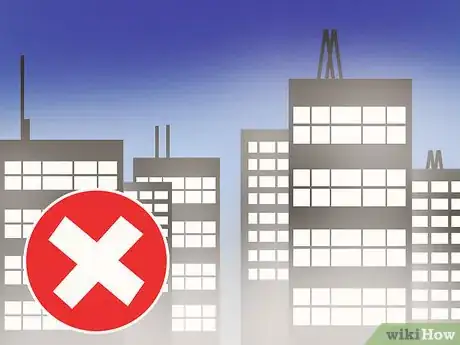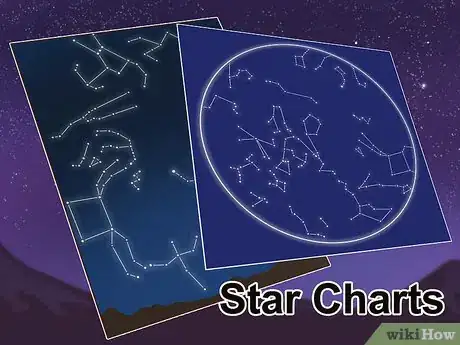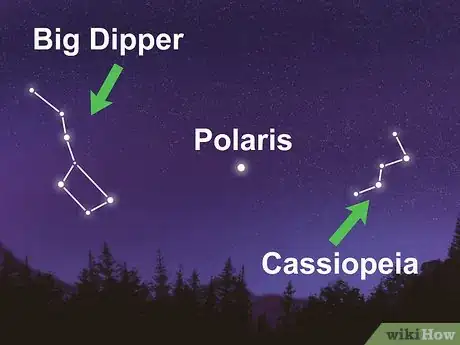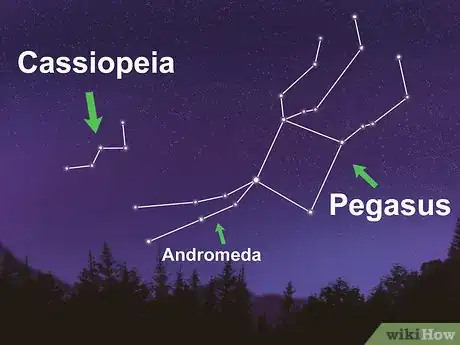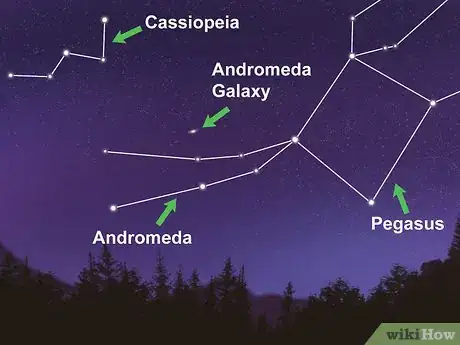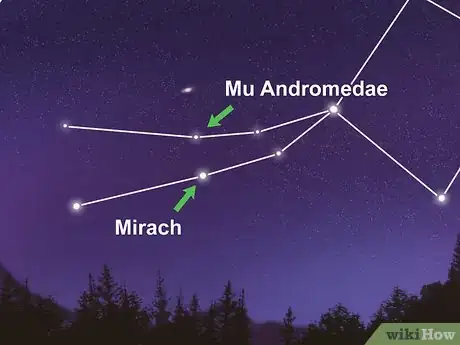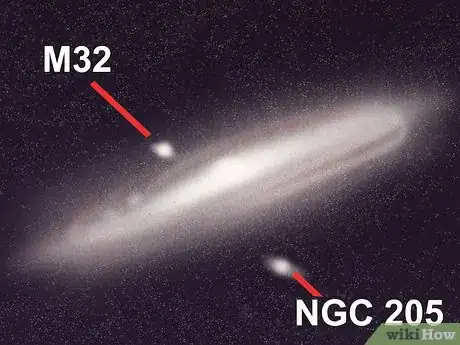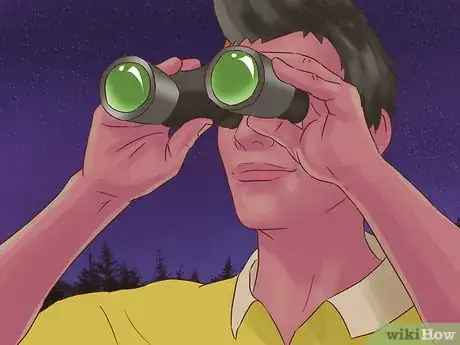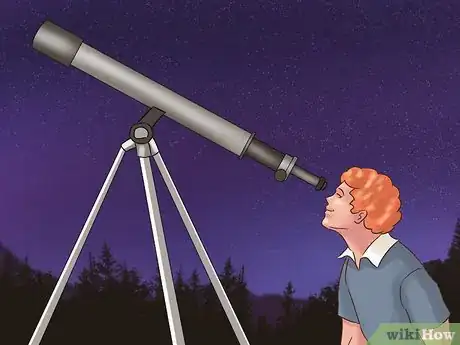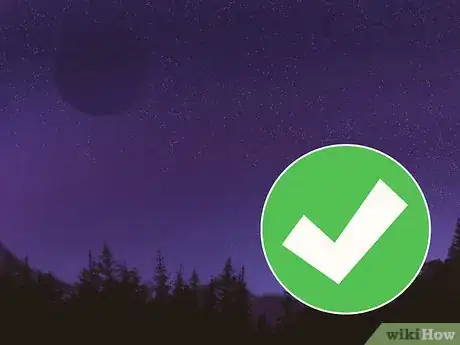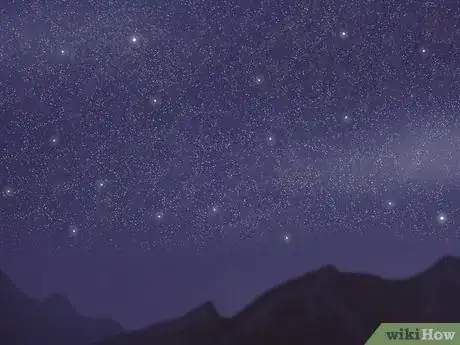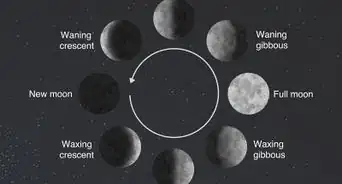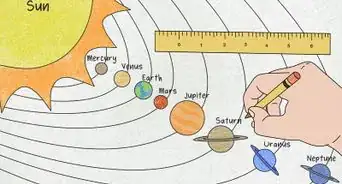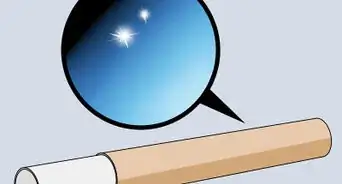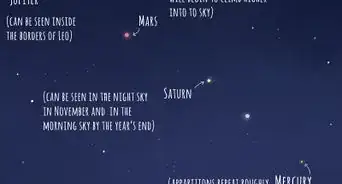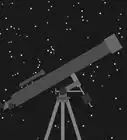This article was co-authored by wikiHow Staff. Our trained team of editors and researchers validate articles for accuracy and comprehensiveness. wikiHow's Content Management Team carefully monitors the work from our editorial staff to ensure that each article is backed by trusted research and meets our high quality standards.
There are 13 references cited in this article, which can be found at the bottom of the page.
wikiHow marks an article as reader-approved once it receives enough positive feedback. This article received 15 testimonials and 88% of readers who voted found it helpful, earning it our reader-approved status.
This article has been viewed 842,644 times.
Learn more...
The Andromeda Galaxy, also known as Messier 31 or "the Great Spiral Galaxy" is one of the most distant objects that the unaided human eye can see. Use the constellations around the Andromeda Galaxy to help you pinpoint its location in the sky. You can see the galaxy faintly with your eyes, but binoculars or a telescope will make it clearer. To maximize your view, go out on a dark night in autumn or winter. Locating it for the first time is a little tricky, but once you find it, it's hard to ever lose it again.
Steps
Locating the Galaxy
-
1Go away from the lights of the city. Any light pollution can make it difficult to find the Andromeda Galaxy. It is best to go away from any urban areas, street lights, or lit parks. Take a hike onto a mountain, go out into an isolated field, or find another area without any light pollution.[1]
-
2Adapt your eyes to the dark. The Andromeda Galaxy is not as bright as other stars around it. When you go out to stargaze, give yourself fifteen minutes to adjust to the darkness. You may realize that you can see more stars than you could at first.[2]Advertisement
-
3Use a star chart to determine where the galaxy will appear in the sky. The position of galaxies, stars, and constellations can change with the seasons. Look for a star chart designed for the current month.
- You can often find star charts for free online. They are also sometimes sold at planetariums or by astronomical societies.
- The star chart may also tell you what the best of time night to see the Andromeda Galaxy is based on the season.
- For example, in September and October, the Andromeda Galaxy will rise in the eastern sky of the northern hemisphere. By midnight, it should be directly above your head.[3]
- If you live in the southern hemisphere, you might look towards the northern horizon in December to see it. It may not rise high in the sky.[4]
-
4Download a stargazing app. There are many apps that can help you find the Andromeda Galaxy and other stars. These will adjust the star charts based on your position, hemisphere, season, and time of night. These include the Star Chart app, NightSky app, and GoSkyWatch.
-
5Locate the Cassiopeia constellation. If you can find the Big Dipper, look for the bright star next to it. This is called Polaris or the North Star. Across Polaris from the Big Dipper will be Cassiopeia. Cassiopeia contains five stars in a “W” shape. The right side of this "W" will point down directly at the Andromeda Galaxy.[5]
-
6Find the Pegasus and Andromeda constellations. Pegasus looks like a giant rectangle. You should see two lines of stars extending from the upper left-hand corner of this star. This is the Andromeda constellation.[6]
- Keep in mind that the Andromeda constellation is separate from the Andromeda Galaxy.
-
7Look between Pegasus and Cassiopeia for a smudge. The Andromeda Galaxy lies between the Pegasus constellation and the point of Cassiopeia. It should look like a blur or a hazy oval in the sky.
-
8Draw a line through the Mirach and Mu Andromedae stars. Start at the star on the upper left-hand corner of Pegasus. The constellation Andromeda begins here. Follow Andromeda down two stars. You should see two stars stacked on top of one another called Mirach and Mu Andromedae. If you draw a line through the two stars and extend it past Mu Andromedae, you should run into the Andromeda Galaxy.[7]
- Mu Andromedae is dimmer than Mirach. It is also the star closest to the Andromeda Galaxy.
-
9Look for the companion galaxies. If you are using a telescope, you may find two faint fuzzy spots beside the galaxy. One of them, M32, is smaller in size and closer to the actual galaxy core. The other, NGC 205, is larger in size, and farther from the actual galaxy. Both are companion galaxies to Andromeda.[8]
Choosing Your Tools
-
1Start by locating the galaxy with your naked eye. You can see the Andromeda Galaxy without any special tools. It will look like a faint, fuzzy oval in the night sky. Once you have found the area of the sky where the galaxy is located, it may be easier to find it with binoculars or a telescope.[9]
-
2Use binoculars for a closer look. Binoculars will give you a closer look at the galaxy. Once you find the galaxy with your eye, bring the binoculars up slowly, and adjust your view until you can find the galaxy. It should look like an oval cloud when viewed through binoculars.[10]
- You can use normal binoculars for this. The best binoculars to use have 7x50, 8x40, or 10x50 lenses.[11]
-
3Use a telescope for a more detailed examination. A typical 8 inches (20 cm) reflector telescope will let you see nucleus (or center) of the galaxy as well as its two companion galaxies. The galaxy is so large that you may not be able to see the whole thing at once using your telescope.[12]
- If you are using a telescope, keep it at the lowest magnification settings. While the Andromeda Galaxy appears quite small to the naked eye, it will appear very large when using a telescope.
Maximizing Your View
-
1Look for the Andromeda Galaxy in fall or winter. In the Northern hemisphere, the best time to view the Andromeda Galaxy is between August and September. In the southern hemisphere, you can see it between October and December. During these seasons, Andromeda will appear as soon as the sky darkens.[13]
- It is possible to view the Andromeda Galaxy all year long in the northern hemisphere, although it may be more difficult to find in other seasons.[14]
-
2Choose a night without a moon. The moon can also dim your view of the stars. You will have the clearest view of the Andromeda Galaxy if you go out during the new moon or a crescent moon.[15]
- If the moon is full, it may be difficult to find the Andromeda Galaxy.
- A new moon occurs once a month. Use an online lunar calendar to find the best night for stargazing this month.
-
3Check the weather for a cloudless evening. Any clouds in the sky will obstruct your view of the stars. Look at weather reports before you head out to make sure that there will be no cloud cover.
Community Q&A
-
QuestionCan I see it from Egypt?
 Community AnswerYou should be able to see it in Egypt, but it may be easier to see it in the northern parts of the country than in the southern areas.
Community AnswerYou should be able to see it in Egypt, but it may be easier to see it in the northern parts of the country than in the southern areas. -
QuestionCan Andromeda be seen from India?
 TomPNTop AnswererYes. It can be seen from anywhere in the northern hemisphere.
TomPNTop AnswererYes. It can be seen from anywhere in the northern hemisphere. -
QuestionHow do I find the Dumbbell Nebula?
 TomPNTop AnswererFind the three stars that make up the Summer Triangle: Deneb, Altair and Vega. The Dumbbell Nebula is in the center of the triangle.
TomPNTop AnswererFind the three stars that make up the Summer Triangle: Deneb, Altair and Vega. The Dumbbell Nebula is in the center of the triangle.
References
- ↑ https://earthsky.org/astronomy-essentials/2-ways-to-find-the-andromeda-galaxy/
- ↑ http://earthsky.org/?p=3659
- ↑ http://earthsky.org/?p=2835
- ↑ http://www.abc.net.au/news/science/2016-12-01/december-sky-guide/8075700
- ↑ http://earthsky.org/clusters-nebulae-galaxies/andromeda-galaxy-closest-spiral-to-milky-way
- ↑ https://earthsky.org/tonight/star-hop-from-great-square-of-pegasus-to-andromeda-galaxy/
- ↑ http://earthsky.org/?p=3659
- ↑ http://www.messier-objects.com/messier-31-andromeda-galaxy/
- ↑ https://www.space.com/152-andromeda-galaxy-visible-eagle-eye-skywatchers.html
- ↑ http://earthsky.org/?p=3659
- ↑ https://astronomynow.com/2015/08/15/see-the-return-of-the-andromeda-galaxy/
- ↑ https://www.space.com/152-andromeda-galaxy-visible-eagle-eye-skywatchers.html
- ↑ http://www.solarsystemquick.com/universe/andromeda-constellation.htm
- ↑ http://earthsky.org/clusters-nebulae-galaxies/andromeda-galaxy-closest-spiral-to-milky-way
- ↑ https://www.space.com/7426-starhopping-101-find-andromeda-galaxy.html
About This Article
To find the Andromeda Galaxy, look between August and September if you live in the northern hemisphere or October and December if you live in the southern hemisphere. Also, wait for a cloudless night when the moon isn't out, which will make the Andromeda Galaxy easier to see. Then, when you're looking in the sky, start by finding the Cassiopeia constellation, which has 5 stars in a "w" shape and is located near the north star. Next, find the nearby Pegasus constellation, which looks like a big rectangle. Finally, locate the hazy oval between Cassiopeia and Pegasus, which is the Andromeda Galaxy. To learn how to use a star chart or stargazing app to find the Andromeda Galaxy, scroll down!
